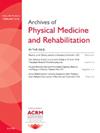Neuromodulatory Effects of Non-invasive Transspinal Stimulation on Spinal Excitability After Incomplete Spinal Cord Injury: A Longitudinal Pilot Study
IF 3.6
2区 医学
Q1 REHABILITATION
Archives of physical medicine and rehabilitation
Pub Date : 2025-04-01
DOI:10.1016/j.apmr.2025.01.079
引用次数: 0
Abstract
Objectives
To study the changes in spinal excitability after noninvasive transspinal stimulation (TSS) after incomplete spinal cord injury (SCI).
Design
MEPs were captured at 3 different timepoints over a period of 21 weeks as a part of a clinical trial. Participants were assigned to a telehealth-home training sessions to undergo cervical TSS, fore-arm electrically evoked blood flow restricted exercise and task-specific training 3 times weekly for 16 weeks.
Setting
Home-based training.
Participants
Four participants with chronic incomplete SCI (AIS B-D), with an age range of 37±14.6 years and time since injury of 2-23 years, were recruited as a part of a clinical trial.
Interventions
Two cathodal electrodes (25mm) were placed between interspinous processes of C3-C4 and C6-C7. Two rectangular electrodes (5 × 10cm) were placed bilaterally over the clavicles. Testing was done at baseline 1 (BL1; before the study), baseline 2 (BL2; 4wk after BL1), and postintervention 1 (P1; 16wk after BL2). The initial 4 weeks were used to educate the participants and their caregivers to safely use the stimulation unit (Ex4, Richmar) at-home setting. Blood pressure was monitored before, during and after the training session. MEP was measured using a stimulation frequency of 1 Hz, a biphasic pulse of 2 msec, and stimulation intensity increased from 1 to 40 mA. MEP data were collected using wireless TRINGO EMG sensors that were placed bilaterally on triceps, biceps, wrist flexor and wrist extensor muscles.
Main Outcome Measures
Recruitment curves were plotted for all muscles at BL1, BL2, and P1 after being normalized to the maximum MEP amplitude versus stimulation intensity. The Boltzmann sigmoidal function was used to calculate the slope of the recruitment curves.
Results
Compared with BL1 and BL2, recruitment curves plotted at P1 for the triceps, biceps, and wrist flexor muscles revealed a noticeable left shift with a trend toward plateauing. Conversely, the recruitment curve of the wrist extensors displayed a nonplateau rise with increasing the stimulation intensity. Finally, the stimulation intensity required to achieve motor threshold decreased over the course of the study.
Conclusions
The findings highlight the neuromodulation effects of TSS and increased excitability of the cervical neural circuitries, which may subsequently enhance neuroplasticity and restoration of motor control in persons with incomplete SCI. The behavior of the wrist extensors curve over time may represent reciprocation of the tenodesis pattern to develop a more natural grasp.
Disclosures
none.
求助全文
约1分钟内获得全文
求助全文
来源期刊
CiteScore
6.20
自引率
4.70%
发文量
495
审稿时长
38 days
期刊介绍:
The Archives of Physical Medicine and Rehabilitation publishes original, peer-reviewed research and clinical reports on important trends and developments in physical medicine and rehabilitation and related fields. This international journal brings researchers and clinicians authoritative information on the therapeutic utilization of physical, behavioral and pharmaceutical agents in providing comprehensive care for individuals with chronic illness and disabilities.
Archives began publication in 1920, publishes monthly, and is the official journal of the American Congress of Rehabilitation Medicine. Its papers are cited more often than any other rehabilitation journal.

 求助内容:
求助内容: 应助结果提醒方式:
应助结果提醒方式:


